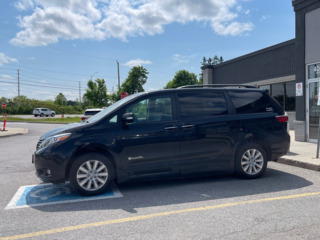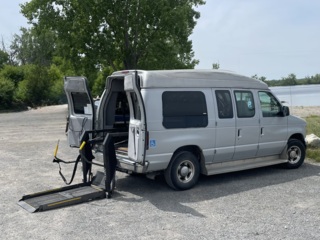¶ Introduction
Accessible vehicles are those that are designed to receive a passenger that has a disability, typically while remaining in their wheelchair.
Most accessible vehicles are based on regular production minivans or full-size vans which are then modified, sometimes significantly, to support the loading and unloading of a wheelchair with a passenger in it.

2011-2020 Toyota Sienna van converted by BraunAbility. Note the lower underbelly and increased ride height (raised suspension) to restore ground clearance.
¶ Start using when…
Anytime; accessible vehicles are useful to those who are able-bodied as well as any level of disability due to ALS
¶ Stop using when…
∞
¶ Entry
Loading and unloading the wheelchair involves driving (or being pushed) up a ramp that folds out, or onto an elevator that raises and lowers the chair. Such systems may be mounted to the side of the vehicle, or to the rear.
¶ Side Entry
Side entry systems are installed on the passenger side of the vehicle, behind the front row seats. Elevators or folding ramp systems are used, depending on the model of vehicle.
Side entry systems may pose greater challenges in confined areas, such as parking garages. However, a side entry system may be safer when parked on along the side of the road.

Side entry wheelchair van with ramp deployed.
¶ Rear Entry
Minivans such as a Dodge Grand Caravan or Toyota Sienna are modified by having a large channel cut into the floor, which has a ramp at the end that folds out. Vans of this type will have an increased ride height, at least at the rear, to prevent the suspension from coming into contact with the channel.
Vans which use a ladder frame construction, such as full-size Ford E-Series vans, will have an unmodified floor and instead have a raised roof placed on top of the bodywork. These vans are often based on camper conversions. An electrically-powered hydraulic wheelchair elevator is used to raise and lower the wheelchair into the rear of the van.

2007 Ford E250 camper conversion van with rear-loading wheelchair lift.
¶ Loading and parking
Loading times for vans with a loading ramp or an elevator are relatively similar.
A loading ramp will still work if the vehicle is not running or has a dead battery, whereas an elevator requires power from the vehicle. The vehicle must be left running during operation of the elevator to prevent draining the battery; this may be a disadvantage if loading and unloading is in a confined space such as an apartment parking garage, where the accumulation exhaust fumes could be an issue.
Vans with a raised roof are typically very tall; some are incapable of fitting in parking garages or through drive-thrus.
¶ Headroom
Headroom is a significant concern with accessible vehicles, especially during loading and unloading. Wheelchairs are typically much taller than the seats that come installed in the vehicle itself. This is especially true for power wheelchairs that have a seat elevator, as even at the lowest height, they are typically taller than wheelchairs without this feature.
¶ Visibility
An individual riding in a power wheelchair may not be able to see ahead due to the rake of the vehicle or shape of the roofline obstructing forward visibility from the rear.
¶ Ride quality
Accessible vehicles often have compromised driving dynamics compared to their unmodified counterparts. Ride quality in full-size vans is never good, especially toward the rear, and the modifications to minivans with sunken floors negatively affects their ride quality as well.
¶ Hitch accessories and towing
Towing is not possible with a van that has a sunken floor at the rear, as there is no place to securely mount a trailer hitch receiver. Vans with an unmodified floor may still be able to tow if the hitch receiver does not interfere with elevator operation. However, the trailer itself, and the drawbar in the receiver would need to be disconnected in order to permit elevator operation. This would add significant time to the process of unloading the passenger from the vehicle.
¶ Resale value
Vans with wheelchair elevators are generally able to be converted back into a standard van with a raised roof, which could then be reused or sold as a camper conversion. The wheelchair elevator itself could be sold independently.
Minivans with sunken floors have irreversible modifications and will forever be wheelchair vans with no other useful purpose.